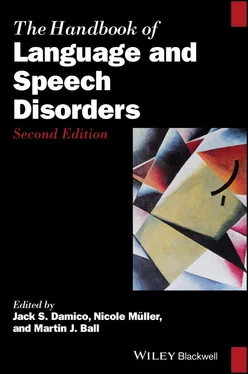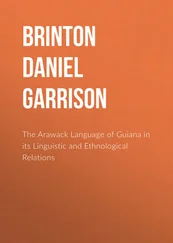56 Weismer, G., & Laures, J. S. (2002). Direct magnitude estimates of speech intelligibility in dysarthria: Effects of a chosen standard. Journal of Speech, Language and Hearing Research, 45(3), 421–433.
57 Weismer, G., & Martin, R. (1992). Acoustic and perceptual approaches to the study of intelligibility. In R. Kent (Ed.), Intelligibility in speech disorders (pp. 67–118). Amsterdam, The Netherlands: John Benjamins Publishing Co.
58 Weiss, C. E. (1982). Weiss intelligibility test. Tigard, OR: CC Publications.
59 Whitehill, T. L. (2002). Assessing intelligibility in speakers with cleft palate: A critical review of the literature [meta‐analysis]. The Cleft Palate‐Craniofacial Journal: Official Publication of the American Cleft Palate‐Craniofacial Association, 39(1), 50–58. doi:10.1597/1545‐1569(2002)039<0050:AIISWC>2.0.CO;2
60 Yoder, P. J., Woynaroski, T., & Camarata, S. (2016). Measuring speech comprehensibility in students with Down syndrome. Journal of Speech, Language, and Hearing Research, 59(3), 460–467. doi:10.1044/2015_JSLHR‐S‐15‐0149
61 Yoho, S. E., & Borrie, S. A. (2018). Combining degradations: The effect of background noise on intelligibility of disordered speech. The Journal of the Acoustical Society of America, 143(1), 281–286.
62 Yorkston, K., & Beukelman, D. (1978). A comparison of techniques for measuring intelligibility of dysarthric speech. Journal of Communication Disorders, 11, 499–512.
63 Yorkston, K., & Beukelman, D. (1980). A clinician‐judged technique for quantifying dysarthric speech based on single‐word intelligibility. Journal of Communication Disorders, 13, 15–31.
64 Yorkston, K., Beukelman, D., & Tice, R. (1996). Sentence intelligibility test. Lincoln, NE: Madonna Rehabilitation Hospital. Retrieved from https://www.madonna.org/institute/software
65 Yorkston, K., Beukelman, D., & Traynor, C. (1984). Assessment of intelligibility of dysarthric speech. Austin, TX: Pro‐Ed.
66 Yorkston, K., Beukelman, D. R., Strand, E., & Bell, K. (1999). Management of motor speech disorders in children and adults (2nd ed.). Austin, TX: Pro‐Ed.
5 Genetic Syndromes and Communication Disorders
VESNA STOJANOVIK
University of Reading, UK
5.1 Why Study Genetic Syndromes?
A syndrome is defined as the presence of multiple anomalies in the same individual with all of those anomalies having a single cause. Different motivations have driven the study and research into genetic syndromes. One strong motivation has been to obtain as much in‐depth knowledge as possible about the behavioral manifestations of a specific genetic syndrome, in order to develop better understanding of the condition and inform diagnosis and intervention. Another reason for studying genetic syndromes (the focus of this chapter) has been the potential contribution that knowledge about genetic syndromes can make to advancing theoretical debates on the role of general cognitive mechanisms for language acquisition. This is because different cognitive skills can sometimes be dissociated, resulting in neurocognitive profiles characterized by relative strengths and weaknesses. With the second reason in mind, the study of genetic syndromes has informed debates about the potential dissociability of language (primarily grammar) from other cognitive skills for the past few decades. According to the Modularity of Mind hypothesis (Fodor, 1983), many of the processes involved in language comprehension are undertaken by special neural systems called modules , whose main feature is informational encapsulation, which means they only have access to certain types of information. For example, a breakdown in the visual system should not affect a person’s processing of tense marking morphology. According to this view, the modular system observed in the adult end state is also present in the infant start state. This view has been challenged, one of the challenges being that modules are not specified innately and that the mind becomes modularized in the process of development under the influence of the environment (Karmiloff‐Smith, 1994, 1998). This view is known as neuro‐constructivism. Developmental disorders provide a naturalistic way of testing the relation between the biological (and psychological) basis of language and the biological (and psychological) basis of other cognitive or neural systems (Marcus & Rabagliati, 2006).
A related issue, which has featured prominently in debates about modularity, is whether cognitive development, including language, in individuals with genetic syndromes follows a developmental trajectory which mirrors the one seen in typical development, or whether due to the genetic abnormality and the consequently altered environment, the developmental trajectory may be atypical. If we assume the innate modularity view, one would predict that language and general cognitive development in populations affected by genetic disorders follow a developmental trajectory that mirrors the one seen in typical development (Pinker, 1999), although one or more components of this system may be anomalous. If we assume the neuro‐constructivist view, then we would predict that a genetic abnormality inevitably affects the developmental pathway, such that development proceeds along an atypical trajectory.
Although it is well established that many genetic syndromes are associated with communication disorders, there is still a large number of disorders for which there is no information available. The six best‐known genetic syndromes as far as language and communication are concerned are: Down syndrome (DS), Williams syndrome (WS), Fragile‐X syndrome, Prader‐Willi syndrome, Cri‐du‐chat syndrome, and Noonan syndrome (Rondal, 2001). This chapter will focus on WS and DS because these syndromes have been particularly implicated in theoretical debates about the status of language within human cognition and also because they have informed debates on innate modularity and neuro‐constructivism.
5.2 Language and Communication in Williams Syndrome (WS)
WS is a rare genetic disorder which is typically found in 1 in 20,000–50,000 live births (Greenberg, 1990), although recent research has reported incidence of 1 in 7,500 (Stromme, Bjornstad, & Ramstad, 2002). It occurs due to a deletion of approximately 25 genes on chromosome 7. The deletion includes the gene ELN, which codes for the protein elastin (Lowery et al., 1995). WS is characterized by physical abnormalities, heart and renal problems, failure to thrive in infancy, a characteristic face morphology known as “elfin” face, and mild to moderate learning difficulties. The WS neurocognitive profile is often described as uneven. This is due to the fact that individuals with WS have moderate to severe learning difficulties, profound impairments in planning, problem‐solving and spatial cognition, but relative strengths in social cognition, linguistic abilities, face processing and auditory rote memory (Mervis, Morris, Bertrand, & Robinson, 1999). Although language abilities tend to improve with increasing chronological age, once individuals with WS reach adulthood, linguistic abilities show relatively little improvement over time (Howlin, Elison, Udwin, & Stinton, 2010). Recent studies also present evidence that structural expressive language skills develop more rapidly than receptive language skills, which may lead to more distinctive language profiles over time (Van Den Heuvel, Manders, Swillen, & Zink, 2016). Also, there is emerging evidence that speech disfluencies in individuals with WS may be a significant marker of language impairment (Rossi, Sampaio, Gonçalves, & Giacheti, 2011).
Some of the first, seminal studies investigating language in WS reported “intact” language, especially with regard to morpho‐syntactic abilities. A number of pioneering studies by Bellugi and colleagues argued that despite severe cognitive impairments, individuals with WS have superior syntactic abilities (Bellugi, Bihrle, Neville, & Doherty, 1992; Bellugi, Marks, Bihrle, & Sabo, 1988; Bellugi, Wong, & Jernigan, 1994). Bellugi and colleagues were the first to suggest that individuals with WS offered evidence that there are clear dissociations between language and other cognitive abilities in the human cognitive system. A number of studies followed in the same direction, presenting data supporting the view that individuals with WS show enhanced grammatical ability compared with lexical ability, and better performance in grammar over lexical semantics (Clahsen & Almazan, 1998, 2001; Clahsen & Temple, 2003; Ring & Clahsen, 2005). These studies have argued that WS offers evidence for dissociations within the linguistic system into a computational component (concerned with rule‐governed operations involved in passive constructions, past tense formation in English, binding) and a lexical component (vocabulary store). In their studies cited above, Clahsen and colleagues showed that individuals with WS perform better with regular grammatical inflections compared with irregular, which involved retrieving items from the lexicon.
Читать дальше












